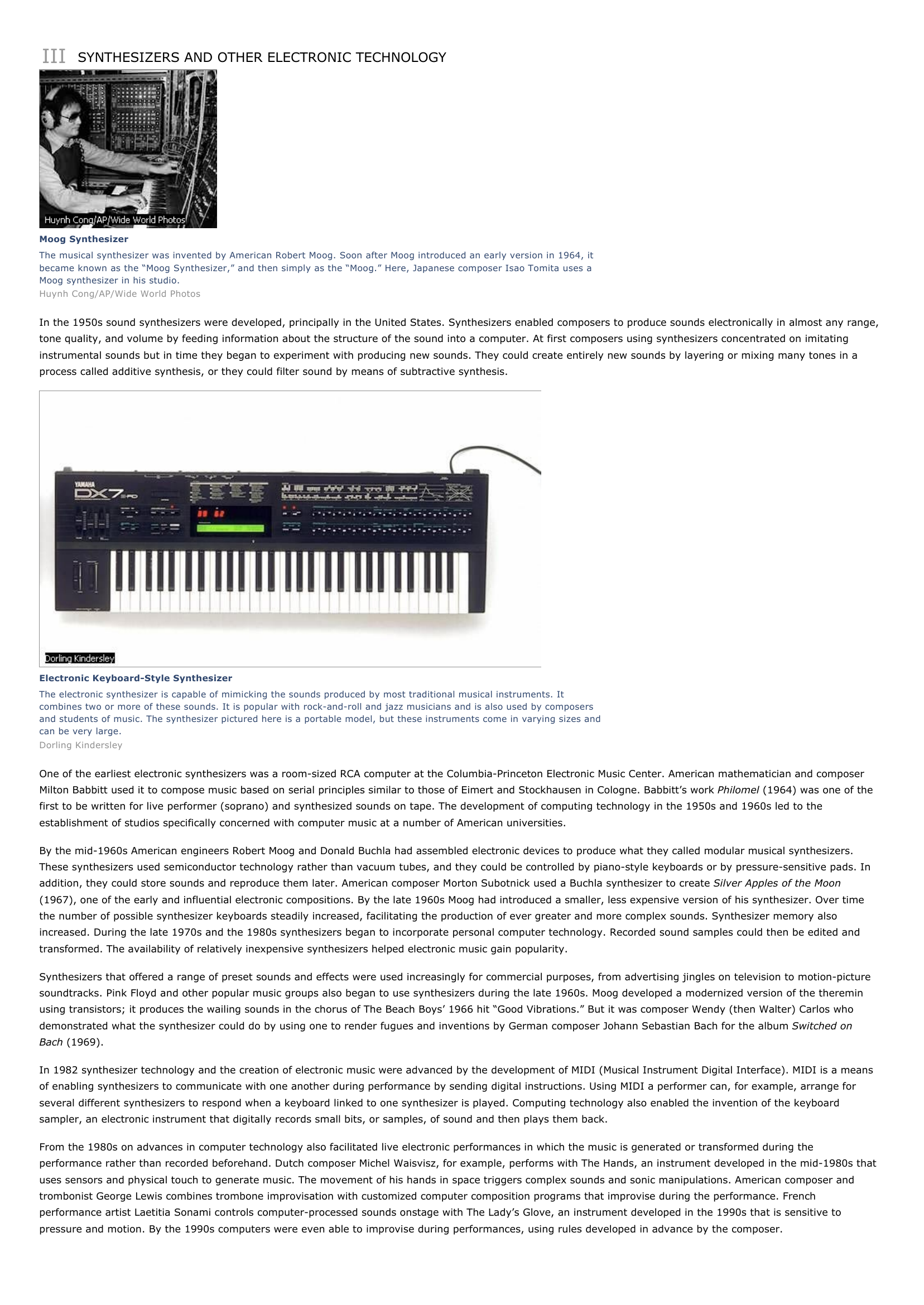Electronic Music I INTRODUCTION Electronic Music, music that requires the use of electronic devices to produce or manipulate sound during its composition and performance.
Publié le 12/05/2013

Extrait du document
«
III SYNTHESIZERS AND OTHER ELECTRONIC TECHNOLOGY
Moog SynthesizerThe musical synthesizer was invented by American Robert Moog.
Soon after Moog introduced an early version in 1964, itbecame known as the “Moog Synthesizer,” and then simply as the “Moog.” Here, Japanese composer Isao Tomita uses aMoog synthesizer in his studio.Huynh Cong/AP/Wide World Photos
In the 1950s sound synthesizers were developed, principally in the United States.
Synthesizers enabled composers to produce sounds electronically in almost any range,tone quality, and volume by feeding information about the structure of the sound into a computer.
At first composers using synthesizers concentrated on imitatinginstrumental sounds but in time they began to experiment with producing new sounds.
They could create entirely new sounds by layering or mixing many tones in aprocess called additive synthesis, or they could filter sound by means of subtractive synthesis.
Electronic Keyboard-Style SynthesizerThe electronic synthesizer is capable of mimicking the sounds produced by most traditional musical instruments.
Itcombines two or more of these sounds.
It is popular with rock-and-roll and jazz musicians and is also used by composersand students of music.
The synthesizer pictured here is a portable model, but these instruments come in varying sizes andcan be very large.Dorling Kindersley
One of the earliest electronic synthesizers was a room-sized RCA computer at the Columbia-Princeton Electronic Music Center.
American mathematician and composerMilton Babbitt used it to compose music based on serial principles similar to those of Eimert and Stockhausen in Cologne.
Babbitt’s work Philomel (1964) was one of the first to be written for live performer (soprano) and synthesized sounds on tape.
The development of computing technology in the 1950s and 1960s led to theestablishment of studios specifically concerned with computer music at a number of American universities.
By the mid-1960s American engineers Robert Moog and Donald Buchla had assembled electronic devices to produce what they called modular musical synthesizers.These synthesizers used semiconductor technology rather than vacuum tubes, and they could be controlled by piano-style keyboards or by pressure-sensitive pads.
Inaddition, they could store sounds and reproduce them later.
American composer Morton Subotnick used a Buchla synthesizer to create Silver Apples of the Moon (1967), one of the early and influential electronic compositions.
By the late 1960s Moog had introduced a smaller, less expensive version of his synthesizer.
Over timethe number of possible synthesizer keyboards steadily increased, facilitating the production of ever greater and more complex sounds.
Synthesizer memory alsoincreased.
During the late 1970s and the 1980s synthesizers began to incorporate personal computer technology.
Recorded sound samples could then be edited andtransformed.
The availability of relatively inexpensive synthesizers helped electronic music gain popularity.
Synthesizers that offered a range of preset sounds and effects were used increasingly for commercial purposes, from advertising jingles on television to motion-picturesoundtracks.
Pink Floyd and other popular music groups also began to use synthesizers during the late 1960s.
Moog developed a modernized version of the thereminusing transistors; it produces the wailing sounds in the chorus of The Beach Boys’ 1966 hit “Good Vibrations.” But it was composer Wendy (then Walter) Carlos whodemonstrated what the synthesizer could do by using one to render fugues and inventions by German composer Johann Sebastian Bach for the album Switched on Bach (1969).
In 1982 synthesizer technology and the creation of electronic music were advanced by the development of MIDI (Musical Instrument Digital Interface).
MIDI is a meansof enabling synthesizers to communicate with one another during performance by sending digital instructions.
Using MIDI a performer can, for example, arrange forseveral different synthesizers to respond when a keyboard linked to one synthesizer is played.
Computing technology also enabled the invention of the keyboardsampler, an electronic instrument that digitally records small bits, or samples, of sound and then plays them back.
From the 1980s on advances in computer technology also facilitated live electronic performances in which the music is generated or transformed during theperformance rather than recorded beforehand.
Dutch composer Michel Waisvisz, for example, performs with The Hands, an instrument developed in the mid-1980s thatuses sensors and physical touch to generate music.
The movement of his hands in space triggers complex sounds and sonic manipulations.
American composer andtrombonist George Lewis combines trombone improvisation with customized computer composition programs that improvise during the performance.
Frenchperformance artist Laetitia Sonami controls computer-processed sounds onstage with The Lady’s Glove, an instrument developed in the 1990s that is sensitive topressure and motion.
By the 1990s computers were even able to improvise during performances, using rules developed in advance by the composer..
»
↓↓↓ APERÇU DU DOCUMENT ↓↓↓
Liens utiles
- The Sound of Music The Sound of Music, motion picture about a religious young governess who brings music and happiness to a widower's large family, set in Austria during World War II (1939-1945).
- Country Music I INTRODUCTION Willie Nelson Country singer and musician Willie Nelson gained national popularity during the 1970s for a string of country hits, including the 1978 hits "Mammas Don't Let Your Babies Grow Up to Be Cowboys" and "Georgia On My Mind.
- Renaissance Art and Architecture I INTRODUCTION Renaissance Composition During the Renaissance (15th and 16th centuries) artists discovered new ways to help them create more realistic and compelling images.
- Nicolaus Copernicus I INTRODUCTION Nicolaus Copernicus (1473-1543), Polish astronomer, best known for his astronomical theory that the sun is at rest near the center of the universe, and that the earth, spinning on its axis once daily, revolves annually around the sun.
- Holocaust I INTRODUCTION Holocaust, the almost complete destruction of Jews in Europe by Nazi Germany and its collaborators during World War II (1939-1945).











